|
|
|
 |
|
|
|
|
|
|
|
|
|
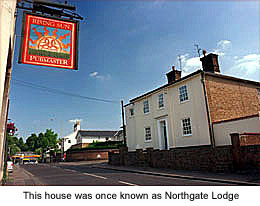 |
|
The house that stands alongside the old Northgate school building was formerly known as Northgate Lodge, home, at the turn of the last century to the Congregational pastor, John Wood (1841–1915). A staunch and vociferous Liberal, he held many positions in local schools and county council, and led district opposition to the 1902 Education Act. Because of his Liberal views, local Conservative supporters of the day once painted the outside of this house blue.
|
|
|
|
|
Yew Tree Place
|
|
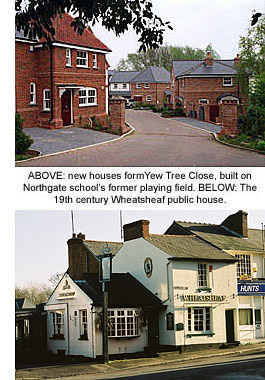 This housing development, constructed in the early 1990s on Northgate school’s former playing field, is an excellent and rare example of traditional style housing built to blend in perfectly with established surroundings. This housing development, constructed in the early 1990s on Northgate school’s former playing field, is an excellent and rare example of traditional style housing built to blend in perfectly with established surroundings.
Likewise, Northbrook House that stands at the top of Yew Tree Place. This 19th century building was in such a poor state of repair in the early 1990s that, in another time, it would have been demolished and replaced by a modern edifice resembling a box. Thankfully, though, attitudes have now changed for the better and the building has been restored and improved to perfection.
For most of the last century, Northgate End was a pleasant mixture of private houses, business premises and shops. Sadly, all of the shops have now gone, including the area's sub-post office. This was just one of 3,000 such post offices earmarked by Post Offices Ltd for closure in 2003, and ended sub-postmaster Mike Talbot's 19-year tenure at Northgate End. MORE PICTURES
|
|
|
|
The Wheatsheaf
|
|
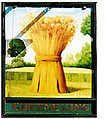 This small 19th century public house has stood in Rye Street for over a century, but with no recorded history available it seems to have led rather a quiet life. MORE PICTURES This small 19th century public house has stood in Rye Street for over a century, but with no recorded history available it seems to have led rather a quiet life. MORE PICTURES |
|
|
|
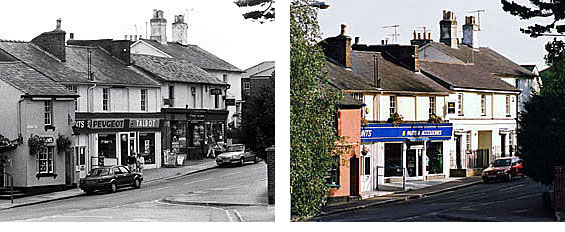 |
|
|
|
The property next to Hunts premises now comprises two private homes – Nos 22 and 24 – but for most of the 20th century up until the late 1980s was Northgate End's 'corner shop'. Established by Bryan Markwell in the early 1900s and selling everything from penny sweets to cooked meat, sliced and weighed to order, the store was latterly run by Bryan's son Geoff. He gave up the business when newly built local supermarkets began taking his trade. The Newsagent who took over the shop fared little better, selling up in 1997, and three years later it was bought by a property developer.
On the opposite side of the road stands a former county court house which, although built of classic red brick around 1917, is distinctly utilitarian with no redeeming features. Despite this the court house, along with the former magistrates court in Basbow Lane, played an important role in Bishop's Stortford's judicial process and was latterly used solely for civil cases. It finally closed on 28 November 1997. The building will eventually be demolished and replaced by private housing. MORE PICTURES
|
|
|
|
Brookhouse Place
|
|
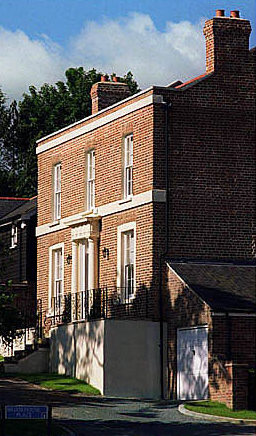 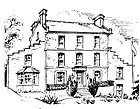 Dominating this new housing development, constructed in 1997/98, is the former Brook House. Originally built in 1820, and now a listed building, it once had two embattled single-storey wings on either side. The house itself has only ever been two-storeys high, so the undated sketch (above) showing it as being three-storeys can only be put down to artistic licence. In its time the property has been used as a private house, a school, a public house and an hotel, and has been known by several names including the Terrace House, Layham House, and Brook End. Dominating this new housing development, constructed in 1997/98, is the former Brook House. Originally built in 1820, and now a listed building, it once had two embattled single-storey wings on either side. The house itself has only ever been two-storeys high, so the undated sketch (above) showing it as being three-storeys can only be put down to artistic licence. In its time the property has been used as a private house, a school, a public house and an hotel, and has been known by several names including the Terrace House, Layham House, and Brook End.
In the mid 1800s it was used as an annexe by the town’s Grammar school while their new school was being built at Hadham Road (See Guide 5), then later became the home of Mr Esam, vice principle of the Collegiate school at Maze Green Road (now Bishop's Stortford College). The same school used it as a classroom and boarding house until 1869, and for a short period after this date it housed the East of England Nonconformist Girls' School, controlled by the same authority that ran the Collegiate school. They held the lease until 1882, after which time it reverted back to private use.
It then became a public house in 1974 but was converted soon after to form part of the Brookhouse Hotel. After this closed in the mid 1980s the building remained empty and derilect, and was almost completely destroyed by a fire that mysteriously broke out at Christmas 1990. Planning permission was finally granted for housing development in the mid 1990s. The remaining hotel buildings were demolished and Brook House renovated and refurbished to become, once again, a private residence. MORE PICTURES
|
|
|
|
|
|
[ BACK TO TOP ] |
|
|
|
|
|
|
|
|
|


 This small 19th century public house has stood in Rye Street for over a century, but with no recorded history available it seems to have led rather a quiet life. MORE PICTURES
This small 19th century public house has stood in Rye Street for over a century, but with no recorded history available it seems to have led rather a quiet life. MORE PICTURES


 This housing development, constructed in the early 1990s on Northgate school’s former playing field, is an excellent and rare example of traditional style housing built to blend in perfectly with established surroundings.
This housing development, constructed in the early 1990s on Northgate school’s former playing field, is an excellent and rare example of traditional style housing built to blend in perfectly with established surroundings.
 Dominating this new housing development, constructed in 1997/98, is the former Brook House. Originally built in 1820, and now a listed building, it once had two embattled single-storey wings on either side. The house itself has only ever been two-storeys high, so the undated sketch (above) showing it as being three-storeys can only be put down to artistic licence. In its time the property has been used as a private house, a school, a public house and an hotel, and has been known by several names including the Terrace House, Layham House, and Brook End.
Dominating this new housing development, constructed in 1997/98, is the former Brook House. Originally built in 1820, and now a listed building, it once had two embattled single-storey wings on either side. The house itself has only ever been two-storeys high, so the undated sketch (above) showing it as being three-storeys can only be put down to artistic licence. In its time the property has been used as a private house, a school, a public house and an hotel, and has been known by several names including the Terrace House, Layham House, and Brook End.